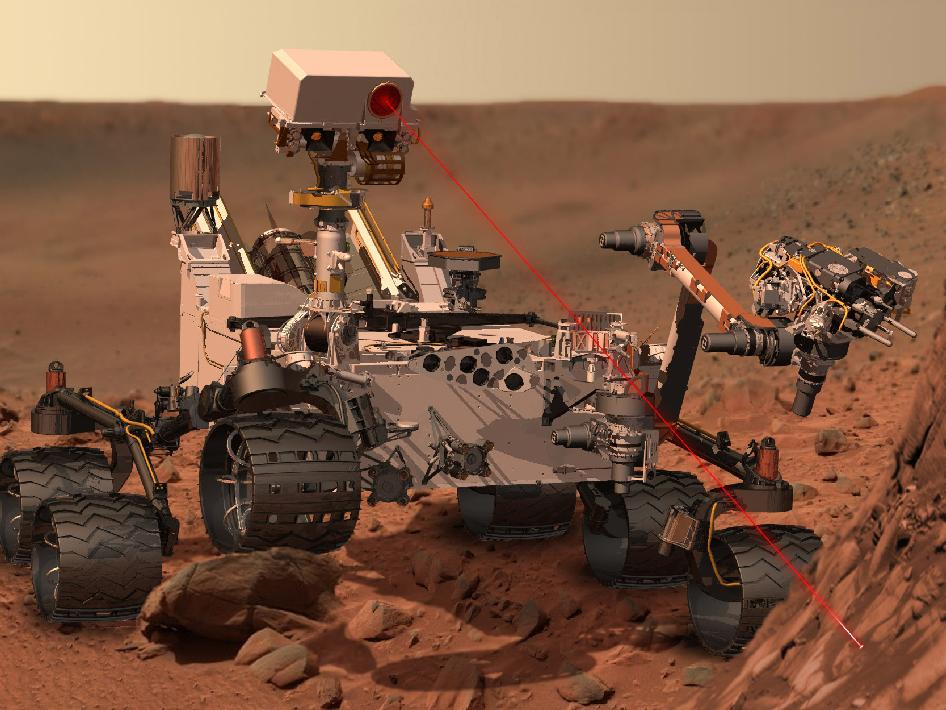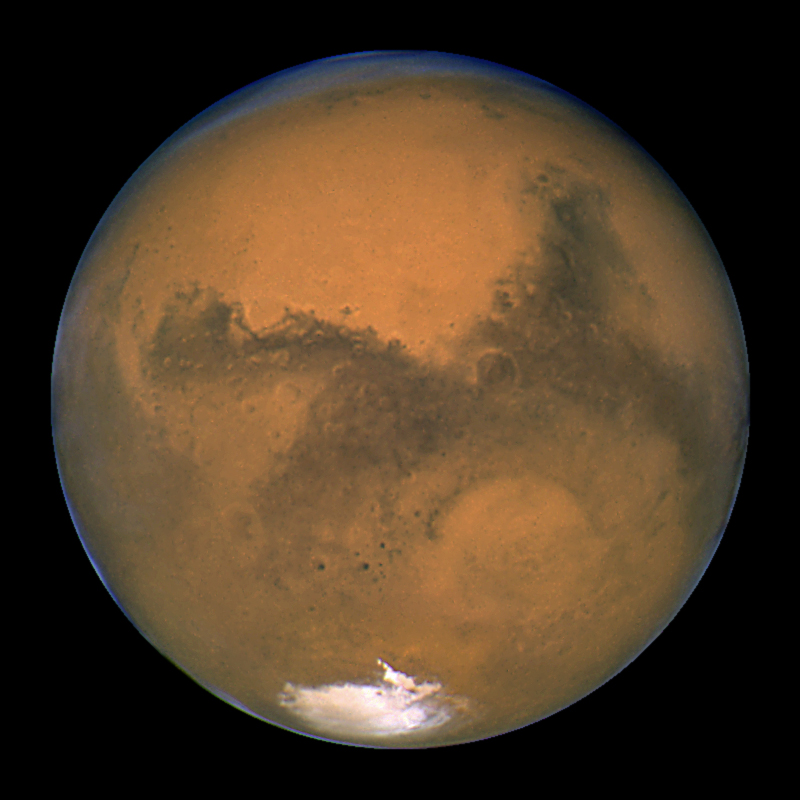Mars Methane Mystery: Curiosity Rover May Find New Clues

There’s growing buzz about data gleaned by NASA’s Mars rover Curiosity, specifically over the issue of methane detection on the Red Planet.
On one hand, methane can be geological in origin. But then there’s the prospect that the gas is biotic, or caused by living organisms — meaning it could be the gaseous residue of long-extinct microbes or even the output of Martian organisms alive and well today.
Toted by Curiosity is the Sample Analysis at Mars (SAM) instrument suite, gear that takes up more than half the science payload on the 1-ton rover. Though SAM’s components would ordinarily fill a laboratory here on Earth, they have been miniaturized to roughly the size of a microwave oven in order to fit inside the robot.
SAM’s duty is to analyze gases that are either "sniffed" directly from the Martian atmosphere (which it has done several times) or extracted from soil or powdered rock samples by heating or chemically treating the samples.
Provided by NASA’s Goddard Space Flight Center, SAM is on the search for compounds of the element carbon, including methane, that are associated with life. SAM will also explore ways in which those compounds are generated and destroyed in the Martian ecosphere. [Mars Methane: Could It Mean Life? (Video)]
According to Goddard's SAM website, determining the presence or absence of organic molecules would be important science results, as either one would provide important information about the environmental conditions of Gale Crater, where Curiosity touched down on Aug. 5.
If SAM does find organic material, the next step would be to determine the origin and the nature of preservation of the molecules.
Breaking space news, the latest updates on rocket launches, skywatching events and more!
But if SAM does not find organic material, a better place to look might be below the surface.
Key question
"The key question about methane on Mars is not its presence, but its variability," said Chris McKay, space scientist and Mars specialist at NASA's Ames Research Center in Mountain View, Calif. As shown by many engaged in the methane-on-Mars issue, it is known that organics are falling onto the surface of Mars and that ultraviolet light produces methane from them, he told SPACE.com.
"So there will certainly be methane at some level, possibly well below one part per billion," McKay said.
"But what was surprising in the Mars Express results and the Earth-based observations was the variability," he added, referring to the European Space Agency's Mars Express orbiter. "Methane on Mars should have a lifetime of 300 years and should not be variable. If it is variable, this is very hard to explain with present theory. It requires unexpected sources and unexpected sinks."
In terms of Curiosity’s SAM instrument, McKay said that the key will be the tracking of whatever methane is seen over time.
"If it’s constant, then this can be reconciled with normal processes and a meteoritic source of organics. If it’s highly variable, then all bets are off." [5 Bold Claims of Alien Life]
Waiting to exhale
"Methane should be there," said astrobiologist Dirk Schulze-Makuch of Washington State University in Pullman. One of his research interests focuses on the interaction of microbes with their natural geological environment in an aqueous medium.
Schulze-Makuch’s view, he said, is based on three independent earlier studies, with methane usually associated with biological activity or ancient biology activity.
"Methane is really quite a rare gas in hydrothermal/volcanic exhalations; thus a methane detection with the rover would be exciting and could point to biology, especially if detected in relatively large amounts," Schulze-Makuch told SPACE.com.
"Even more exciting," Schulze-Makuch said, "would be if the carbon in the methane has an isotopic fractionation that is consistent with biology. If the methane is produced by organisms — for example, metabolism — then we expect a shift to the lighter isotopes. In essence because life is lazy, same effect, with less work compared to inorganically produced carbon."
Whether any Mars methane detections would be sufficiently high to determine the isotope ratio, Schulze-Makuch said, is a wait-and-see moment. "But it would be very exciting. To try and determine the isotopic fractionation and a good inorganic baseline for carbon would be the next step in my view." [7 Biggest Mysteries of Mars]
Modeling research
Malynda Chizek, an astronomy graduate student at New Mexico State University, recently outlined her research results on mapping the simulated methane distribution during different seasons on Mars. She presented her findings during last week’s American Astronomical Society’s Division for Planetary Sciences (DPS) meeting in Reno, Nev.
Chizek told SPACE.com that she too is eager to see the Curiosity results announced.
Chizek is working on computer simulations using the NASA/Ames Mars Atmospheric General Circulation Model to replicate trace gases in the Martian atmosphere. Her modeling research enables the tracing back of detected methane to its source location to see whether it is coming from something like a volcanic source, water surface chemistry interaction or bacteria living on or near the surface.
Counting cows
Chizek said that there have been several claims of methane detection in the past decade, from Mars-orbiting spacecraft as well as telescopic observations from Earth. But those claims tend to be controversial, she said, because observations suggest that it’s varying in abundance on a very quick time scale, which is unexpected.
Detecting methane on Mars could lead to evidence of life, as roughly 95 percent of the methane in Earth’s atmosphere is a product of biology, Chizek said. In her recent talk at the DPS meeting, she underscored the volume and significance of methane on Mars by using a very Earthly creature that produces the gas: cows.
So how many cows would be required to equal the amount of methane that scientists have observed on Mars?
"Depending on which observations I am looking at, that number is close to 5 million cows, or roughly 200,000 tons of methane production per year," Chizek reported.
What next?
Whatever methane news the Curiosity rover uncovers, more work is ahead, Chizek said.
"In order to constrain the Martian methane origin, I would need to know about the variation in methane measurements by Curiosity over time. So, I would want the rover to take many more measurements, which I assume is the plan if they do detect methane," Chizek said.
Chizek said that if there is only about a plus/minus 10 percent variation over time, then it might suggest that the methane is leftover from some unknown event in the past.
"If the methane abundance variation has a definite seasonal variation, then it might suggest some sort of biological origin, although there are also some geological mechanisms which might respond to seasonal change," Chizek said. "If there is a random, sporadic change in methane abundance, then I think it would likely be a geological production or release mechanism."
Chizek added that the latter two also require an as-yet unknown methane destruction or removal mechanism, while the 10 percent variation is what would be expected, shored up by current knowledge of long-lived, noncondensing gases in the Martian atmosphere.
"Mars is thought to be a geologically dead planet," Chizek said in a statement released by New Mexico State University. "If the methane detections are confirmed, and we do not find any signs of bacterial life, this means there are likely some interesting geological processes happening on Mars that we don’t yet know about."
Leonard David has been reporting on the space industry for more than five decades. He is a winner of last year's National Space Club Press Award and a past editor-in-chief of the National Space Society's Ad Astra and Space World magazines. He has written for SPACE.com since 1999.

Leonard David is an award-winning space journalist who has been reporting on space activities for more than 50 years. Currently writing as Space.com's Space Insider Columnist among his other projects, Leonard has authored numerous books on space exploration, Mars missions and more, with his latest being "Moon Rush: The New Space Race" published in 2019 by National Geographic. He also wrote "Mars: Our Future on the Red Planet" released in 2016 by National Geographic. Leonard has served as a correspondent for SpaceNews, Scientific American and Aerospace America for the AIAA. He has received many awards, including the first Ordway Award for Sustained Excellence in Spaceflight History in 2015 at the AAS Wernher von Braun Memorial Symposium. You can find out Leonard's latest project at his website and on Twitter.



